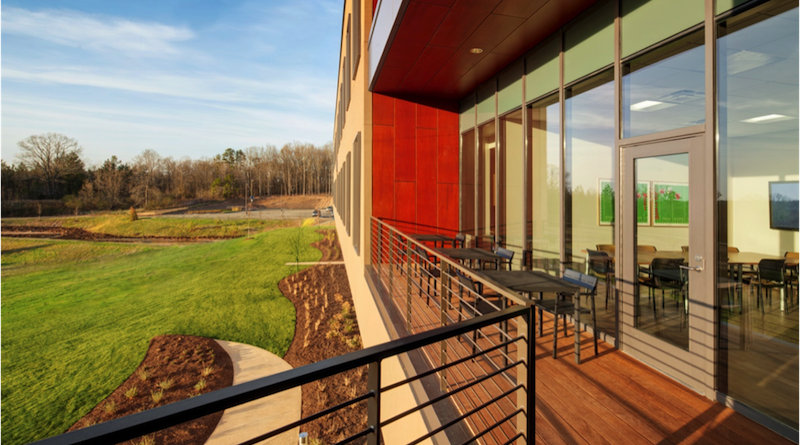How to Attain Net Zero Energy for Large-Scale Facilities
By Lisa Matthiessen
Conversations — and aspirations — around high-performing buildings have evolved quickly. Ten years ago, we dreamed of achieving LEED certification on high energy building types such as hospitals and labs. Net zero energy buildings were a costly pipe dream, at best available to small buildings with low energy needs. In 2018, the New Buildings Institute lists 67 “verified” and 415 “emerging” zero energy (ZE) projects. It’s safe to say that net zero appears ready to take over the market much as LEED did a few short years ago.
This remarkable transformation can be attributed both to advances in technology and to a growing understanding of the integrated design process.
Net zero design depends on two key elements, the reduction of energy demands and the on-site production of energy. Successful projects strive to reduce energy use to the point that on-site production is feasible and cost-effective. With widespread acceptance of technologies that were previously viewed with suspicion — the use of radiant beams in laboratory or displacement ventilation in hospitals, for example — it becomes possible to reduce energy demands to the point that on-site production becomes viable. The precipitous drop in photovoltaic panel prices completes the picture; in many cases, it can be less expensive to buy solar panels than to invest in complicated HVAC systems.
Advances in technology alone do not explain this market change; the real source of change is the growing implementation of integrated design processes.
Integrated design demands an expansion of the project “team.” Rather than a linear process led by the architect, high-performance project teams expect continuous and proactive engagement not only from the full design team, including engineers and other consultants, but also from the contractor, owner and end users. The process typically proceeds as follows:
- Architect and engineers determine appropriate energy-use goals for the project. These are typically described in terms of Energy Use Intensity (EUI).
- Engineers determine the parameters for net zero design for the given project. How much power can be provided on site? Most projects carry certain limitations related to available site or roof area, and so the energy use reduction goals for a project are directly related to the ability to produce power. In other words, if a project is able to generate power adequate for 50 EUI, then the energy-use goals for that project are now 50 EUI. This simple formula can be very effective; design teams perform well in the face of hard targets.
- The entire team — owners, users, designers and contractors — comes together to work through the many elements that contribute to energy-use reduction.
- Passive Design: Passive architectural design comes first as building massing, zoning, envelope and orientation are fine-tuned to enhance building performance. Key foci include the use of natural daylight and ventilation and the protection of interior spaces from direct solar gain.
- Active Design: Heating, cooling, lighting and ventilation systems are designed to work with passive design elements. HVAC systems are reduced in size and cost, offsetting added costs for passive design elements.
- Occupant Behavior: Ten years ago, a team might focus on the first two steps above. However, as project teams squeeze every opportunity to reduce energy out of architecture and building systems, the role of end users and building managers becomes crucial. In many high-performing projects, plug loads become the single biggest use of energy. Successful teams engage occupants to find ways to reduce ongoing energy use on multiple levels. Some solutions involve technology such as the use of sensors to turn equipment off when not in use. Others go back to the layout of the building. Can lab users be persuaded to share high-energy equipment such as freezers? Procurement comes into play; the design team for the Net Zero Packard office in Palo Alto, Calif., recommended that the owners buy Apple screens for their low-energy use. In response, Hewlett-Packard came out with its own low-energy screens.
- Design Process: The above steps are taken in tandem, not sequentially. Models are built of energy, water, daylight, comfort and cost, and constantly updated to test technologies and strategies in relation to one another. Real-time analysis replaces historical data and formulas, allowing teams to adjust to the specifics of the project at hand; no cookie-cutters allowed.
- Ongoing operations. Finally, and perhaps most importantly, zero energy requires that a building actually operate at net zero for a certain period of time, typically two years, before being declared successful. This requirement highlights the need for users and designers to work together; one cannot succeed without the other, and it turns out that connection and buy-in are crucial.
Ultimately, the trend towards net zero energy will yield tremendous results across the industry because the goals are aggressive, strictly defined and ultimately require true collaboration across all members of the team.
Lisa Matthiessen is the national sustainable design director at HGA, an architecture firm with locations across the country.

